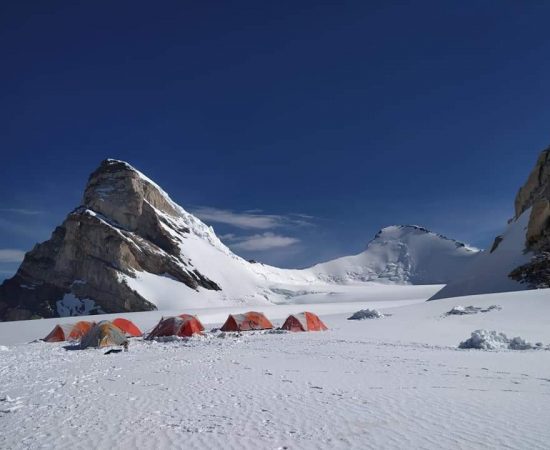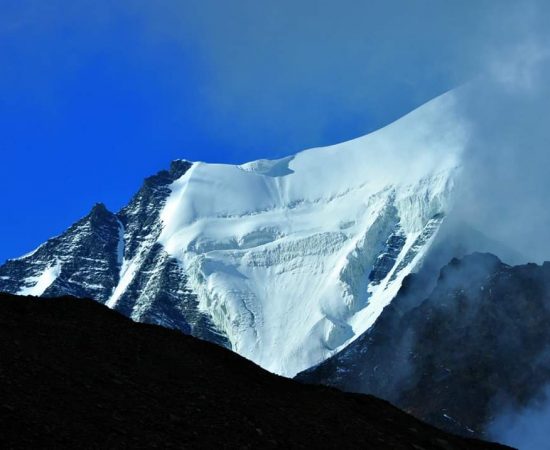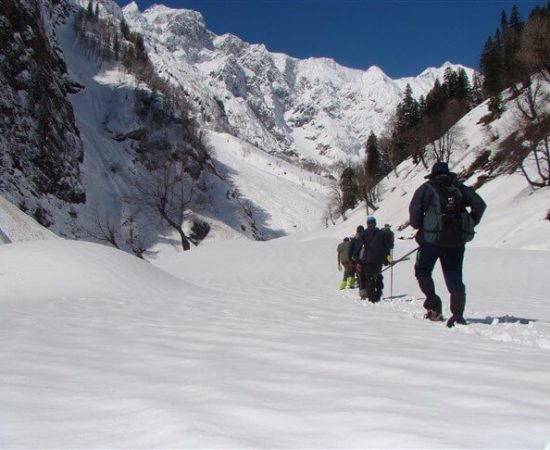SASER KANGRI I EXPEDITION
Panamik, Himachal Pradesh
Rated 4.9/5.0 on TripAdvisor. 550 Reviews

572 Reviews (5.0)
5/5

572 Reviews (5.0)
5/5
Key Highlights
- Altitude : 7672mtr
- Time : 35 Days – 34 Nights
- Region: Nubra Valley
- Best Time: May, June and Septembrt, October
- Grade: Difficult
Overview
Saser Kangri 1 Expedition
The highest point of the Saser Muztagh, the easternmost subrange of the Karakoram, is Saser Kangri I. The mountain is found in the far northern part of the Indian state of Jammu and Kashmir, in an area known as Laddakh. From the highest peaks, the brilliant yellow granite rock that gives SaserKangri its name stands out. The mountain is located in the vast Karakorm range, between the rivers Nubra and Shyok. Seven glaciers encircle the Saserri, and the mountain range is protected by sheer cliffs and ice. The SaserKangrimounatins are strategically located along the main artery between India, Tibet, and Russia. SaserKangrimassif comprises of six peaks, the tallest of which is SaserKangri I; it is located at the head of north ShukpaKunchang Glacier, a large glacier that drains the eastern slopes of the group. The Nubra River receives runoff from the western edge of the group, where the Sakang and Phukpoche glacier heads begin. Since its initial ascent in 1972, the SaserKangri I has been consistently ranked as one of the most technically and physically challenging peaks in the nation.
May to around the middle of October is prime season for a Stok Kangri peak trip. The climate during this time of year is The Ladakh area has a lovely environment with temperatures between 20 to 30°C at this period. Read More
Cost Per Person
₹ 1,30,500
₹ 1,12,240
Key Highlights
- Altitude : 7672mtr
- Time : 35 Days – 34 Nights
- Region: Nubra Valley
- Best Time: May, June and Septembrt, October
- Grade: Difficult
Complete
Itinerary of Expedition
You will be met at the airport in Delhi by a representative of our company, and then you will be transferred to the hotel to check in and spend the night there.
Visit the Indian Mountaineering Foundation (IMF) in the morning after breakfast at your hotel. While there, you will participate in a briefing and meet other Indian members, as well as the Liaison Officer for your expedition and the IMF Director.It’s time to get back to the hotel for the night.
We will get you to the Delhi airport bright and early this morning so that you can catch your trip to Leh. After arriving in Leh, check into your accommodation. The rest of the day is at your convenience. Hotel accommodations for the night in Leh.
In the morning, after breakfast, we will pick you up and take you on a walk to Leh Palace and Shanti Stupa. The rest of the day is at your leisure to get acclimated or go shopping in Leh. In the evening, you have the option of going to the closest market on your own or just spending some time doing whatever you choose. Spend the night at the hotel.
Day5: From Leh to Panamik to Phukpuche
After breakfast, we will check out of the hotel and begin driving to Panamik. En route, we will go through the Khardung La Pass, which is the highest motorable pass in the world at 5602 metres. Upon arriving at Panamik, continue driving in the direction of Phukpuche. Tent or homestay accommodations for the night.
Day at your disposal to become acclimated, finish the paperwork, and organise the logistics. Spend the night at the lodge or the host’s house.
Day7: From Phukpuche to base camp
It will be a long day as we may require up to eight hours to reach base camp, so we will begin our walk to base camp after breakfast in the morning. Upon arriving, establish a base camp in preparation for spending the night there.
Day8-Day31- From Base camp to summit and back
Day 08 through 31 establishing higher camps, summiting Mt. Saser Kangri – 1, and then descending down to Base camp are the objectives of this climb.
Day32: From Base camp to Panamik
Trek Back to Panamik. Spend the night at the camp or at the host’s house.
Make your way to Leh. Hotel room for the night’s stay.
Check out of the hotel in the morning, and then take a shuttle to Leh Airport so you can catch your flight to Delhi. Upon arrival in Delhi, proceed to the Indian Mountaineering Foundation in Delhi for a (De-briefing) meeting with the IMF Director. Hotel room for the night’s stay.
In the morning, after a leisurely breakfast, we will drive you to the international airport so that you may begin your journey.
Enquiry For Group Bookings
Guidelines
➽ Preparation for Expedition
During the wonderful Himalayan trek, mind, body, and spirit must all be overcome, as you well know. Precise preparation, with appropriate pliability of observing and confronting circumstances, is essential. Due to the difficulty and unpredictability of expeditions, participation is limited to those who have completed trekking at altitudes of at least 4,500 metres at least four to five times or have finished a Basic Mountaineering course.
The following are some considerations for the Saser Kangri 1 Expedition:
⦿ Physically – An Expedition requires a lot of physical endurance, therefore you should start working out a month before signing up for a programme. Strengthen your legs by jogging and working out regularly to increase your stamina. To better acclimatise to the environment and increase your resilience on the walk, you should give up smoking and undertake breathing exercises twice a day. Participate wholeheartedly in sports, Yoga, and other cardiovascular activities. Sometimes you have to climb for 20 hours straight, therefore you need to be ready to push yourself to the maximum, which is only possible with well-defined pre- and post-climb training.
⦿ Mentally – As essential as physical training is for an Expedition, so too is mental preparation. Relax, enjoy your regular activities, and take care of yourself before embarking on an Adventure. Don’t put yourself through mental anguish by making guesses or planning ahead for the Expedition. Get together with your closest pals to rejuvenate and refocus your thinking. After you join the March and meet the rest of the pack, you will find encouragement and excitement, proving that your pre-expedition preconceptions were unfounded. As you endure the hardships of the journey, both your mental and physical toughness will increase. Hence, as you make your way up to each campground, it’s a good idea to pay attention to different sections of the body and actively relax them. Focus on the path or whatever perilous terrain you must carefully handle when climbing, and attempt to relax your body. Try out a few new walking techniques to add some fun to your commute that has nothing to do with getting anywhere. The best way to keep one’s mind in good shape when traveling is to relax and enjoy the ride.
⦿ Technically –
Choose the right size of trekking or climbing shoes and walk with it, from a technical standpoint. Fill a 60-liter container. Carry as much as you can in your rucksack on a regular basis to become accustomed to walking lengthy distances with it. You should equip yourself with a trekking pole, water bottle, warm socks, thermals, fleece, feather jackets, cap, trousers, poncho, flip flops, and any necessary equipment like a power bank and camera (DSLR or digital camera). Get a sling and use it to perfect the primary knots you’ll need for the ascent.
The rewards of a successful mountain ascent are well worth the effort required to reach the top, which may be as daunting as the mountain itself. The Himalayan Adventure Tours Expedition to Mighty Mountain Saser Kangri 1 awaits your honest participation.
Guidelines
➽ Things to Carry
- T-shirts
- Trekking Pants, Lowers that are thick and heated
- Windproof jacket, Jacket stuffed with down, ideally one that has a hood
- Fleece, which is warm and dense.
- Sweater made of wool with full sleeves
- Thermoregulating undergarments (upper & lower).
- Accessories made of wool, including a woollen hat, woollen gloves, woollen socks, and ordinary socks (3-4 pairs).
- a Balaclava, a woollen hat, or a scarf or silencer (the latter two are optional).
- Comfy Trekking/Hiking shoes (shoes with a thick sole are recommended).
- Towel with a Low Weight (1 unit).
- Toilet Paper (plenty).
- Wet-Tissue Papers (plenty).
- Floaters, sandals, or slippers that are not too heavy
- Poncho or raincoat, etc. Towel of a small size and low weight.
- a container for water.
- Sunscreen Lotion.
- Use a cap to shield the harsh rays of the sun from your face, Sunglasses.
- Stick or Trekking Pole, Head Torch or Headlamp, and Walking Stick or Trekking Pole (with extra batteries).
- Medications (if required any specific drug) (if requiring any particular medication).
- Personal hygiene products.
- You should have a day pack or another compact backpack that you can sling over your shoulder and carry with you wherever you go.
- A camera with its batteries fully charged.
Guidelines
➽ How to Reach
Travel time and distance by road:
You will begin your journey in Delhi, and then go to Karnal, Mandi, Manali, Jispa (through Rohtang Pass), Sarchu, and Tanglang La before finally arriving in Leh, which is your final destination.
Distance: 1011 kilometres (approx.)
Airports in Closest Proximity:
The most convenient method of travel is flying. Delhi is the central destination. There is just one flight every day that departs from Delhi and lands in Leh. There are three airlines that provide flight services between New Delhi and Leh: Jet Airways, Air India, and Go Air. Since prices tend to go up after a certain amount of time has passed, it is in your best interest to make your reservations as far in advance as possible. It is almost hard to go by road since the surrounding mountains are covered with snow. Flight is by far the most popular option.
➽ Trip Cost Includes
- Mountaineering (Instructor/guide) services provided by a highly trained, professional, and qualified Himalayan Adventure Trips staff.
- Certified local guide with extensive familiarity of the area.
- Climbing provides only vegetarian food (breakfast, lunch, and dinner).
- Staff include chefs, cooks, and helpers.
- High Altitude Force, Low Altitude Force, Porters, Mules for Common Equipment (Rations, Tents, Utensils, Central Climbing Equipment, etc.)
- Tents (to be shared), sleeping bags, air mattresses, and air pads are included. Inner
- We offer twin-share accommodations in dome, alpine, and high-altitude tents on all of our treks and expeditions. All necessary camping equipment, including air mattresses, a shelter for cooking and eating, a table and chairs, a stool, and more, would be supplied.
- Someone who can carry heavy items, set up high camps, repair ropes, etc. at high altitudes.
- Assistance from Guide All the Way to the Top
- High-altitude butane gas cooker
- The only meal offered at the hotel will be breakfast. All meals while on the walk will be supplied for you. Indian, Chinese, and Continental cuisines, all freshly cooked, will be on the menu.
- Tin-packaged food is what we’ll eat at high altitude.
- A standard first aid kit with oxygen masks for the patient.
- Camping fees, wildlife fees, and forest permits.
- Taxes imposed by the state.
➽ Trip cost Excludes
- Climbers may hire individual porters to carry their gear.
- Airport transportation costs
- Expenses for carrying still/video cameras etc.
- Irregular/Personal costs, such as laundry, phone calls, and gratuities.
- Climbing equipment such as ropes, pitons, snow bars, crabs, etc.
- Your own personal mountaineering equipment and clothes, as well as any specialised foods you may need
- Inner Line Permit.
- Health coverage or the price of a rescue mission
- Expenditures of a more personal character (such as booze, soda, bottled water, mineral water, canned or bottled drinks, candy, canned or packaged dried fruits, etc.)
- Provisions/food to or from the starting point of the trek.
- Any expenses that are incurred as a result of natural disasters, human error, or other unforeseeable occurrences.
- Protect your trip with a travel insurance policy.
- Authorization, licensing, and enlistment with the IMF.
- Payment for Liaison Officer (included for foreign expedition only)
- GST of 5%.
Guidelines
➽ Special Casual Leaves
Government employee can avail the benefit of special casual leave when u join us for a trekking expedition. As per the rule of the pay commission, special casual leave can be availed for up to 30 days in a calendar years for trekking and mountaineering expeditions through a register organization. Himalayan adventure trips are a register adventure tour operator register with Indian mountaineering foundation and Himachal Pradesh tourism. Candidates have to apply for leave at least 30 days before the trek/expedition start.
Memories
CAPTURED BY OUR TEAM
Testimonials
➽ Provided By The Customers
Climbing Hanuman Tibba in August 2019 with Good Company
In the company of Hat, Sameer, Arun, and I climbed to the summit of Hanuman Tibba (at an altitude of 5932 metres). With Shera at the helm as the chief guide, along come Vishal, Panna, and Jaggi, who work together to form a tight-knit, effective, and amiable unit. The majority of our time was spent in a high-quality 4-person tent; the given gear was not brand new but adequate, with the exception of a few small difficulties with one of the sleeping bags. Both the meal and the hot beverages were delicious. Manu was simple to get in touch with before to our adventure, and he answered all of our questions (there weren’t many) thoroughly. Basically, my time spent on adventure with Himalayan Adventure Trips was both personally rewarding and professionally enriching.
Professor Atul Deokar, Ph.D.
Explore
➽ Other Related Expedition





